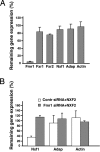Fragile X mental retardation protein FMRP and the RNA export factor NXF2 associate with and destabilize Nxf1 mRNA in neuronal cells
- PMID: 17548835
- PMCID: PMC1891223
- DOI: 10.1073/pnas.0700169104
Fragile X mental retardation protein FMRP and the RNA export factor NXF2 associate with and destabilize Nxf1 mRNA in neuronal cells
Abstract
Fragile X syndrome is caused by the inactivation of the X-linked FMR1 gene, leading to the loss of its encoded protein FMRP. Although macroorchidism and defects in neuronal architecture and function have been associated with lack of FMRP, the exact molecular mechanism underlying this disease remains unclear. We have reported previously that in the brain and testis of mice, FMRP specifically interacts with a distinct mRNA nuclear export factor NXF2 but not with its close relative NXF1, a ubiquitously expressed essential mRNA nuclear export factor. This interaction marked NXF2 as a putative functional partner of FMRP. Here, we demonstrate by immunoprecipitation and quantitative real-time RT-PCR that, in cultured mouse neuronal cells, both FMRP and NXF2 are present in Nxf1 mRNA-containing ribonucleoprotein particles. Further, we show that expression of NXF2 leads to the destabilization of Nxf1 mRNA and that this effect is abolished when Fmr1 expression is reduced by siRNA, arguing that both proteins collaborate to exert this effect. Importantly, these findings correlate well with our observations that in both mouse hippocampal neurons and male germ cells where the expression of FMRP and NXF2 is most prominent, the expression of NXF1 is relatively poorly expressed. Our studies thus identify Nxf1 mRNA as a likely biologically relevant in vivo target of both FMRP and NXF2 and implicate FMRP, in conjunction with NXF2, as a posttranscriptional regulator of a major mRNA export factor. Such regulation may prove important in the normal development and function of neurons as well as of male germ cells.
Conflict of interest statement
The authors declare no conflict of interest.
Figures





Similar articles
-
The fragile X mental retardation protein interacts with a distinct mRNA nuclear export factor NXF2.RNA. 2006 Aug;12(8):1446-9. doi: 10.1261/rna.94306. Epub 2006 Jun 21. RNA. 2006. PMID: 16790844 Free PMC article.
-
Fragile X mental retardation protein control of neuronal mRNA metabolism: Insights into mRNA stability.Mol Cell Neurosci. 2010 Jan;43(1):43-50. doi: 10.1016/j.mcn.2009.09.013. Epub 2009 Oct 22. Mol Cell Neurosci. 2010. PMID: 19837168 Review.
-
NXF2 is involved in cytoplasmic mRNA dynamics through interactions with motor proteins.Nucleic Acids Res. 2007;35(8):2513-21. doi: 10.1093/nar/gkm125. Epub 2007 Apr 1. Nucleic Acids Res. 2007. PMID: 17403691 Free PMC article.
-
Expression of fragile X mental retardation-1 gene with nuclear export signal mutation changes the expression profiling of mouse cerebella immortal neuronal cell.Proteomics. 2005 Oct;5(15):3979-90. doi: 10.1002/pmic.200401252. Proteomics. 2005. PMID: 16130171
-
New insights into fragile X syndrome: from molecules to neurobehaviors.Trends Biochem Sci. 2003 Mar;28(3):152-8. doi: 10.1016/S0968-0004(03)00033-1. Trends Biochem Sci. 2003. PMID: 12633995 Review.
Cited by
-
Identification and Analysis of ZIC-Related Genes in Cerebellum of Autism Spectrum Disorders.Neuropsychiatr Dis Treat. 2024 Feb 22;20:325-339. doi: 10.2147/NDT.S444138. eCollection 2024. Neuropsychiatr Dis Treat. 2024. PMID: 38410689 Free PMC article.
-
Concise review: Fragile X proteins in stem cell maintenance and differentiation.Stem Cells. 2014 Jul;32(7):1724-33. doi: 10.1002/stem.1698. Stem Cells. 2014. PMID: 24648324 Free PMC article. Review.
-
New X-chromosomal interactors of dFMRP regulate axonal and synaptic morphology of brain neurons in Drosophila melanogaster.Biotechnol Biotechnol Equip. 2014 Jul 4;28(4):697-709. doi: 10.1080/13102818.2014.937897. Epub 2014 Oct 23. Biotechnol Biotechnol Equip. 2014. PMID: 26740770 Free PMC article.
-
Desmoplakin and talin2 are novel mRNA targets of fragile X-related protein-1 in cardiac muscle.Circ Res. 2011 Jul 22;109(3):262-71. doi: 10.1161/CIRCRESAHA.111.244244. Epub 2011 Jun 9. Circ Res. 2011. PMID: 21659647 Free PMC article.
-
BC1-FMRP interaction is modulated by 2'-O-methylation: RNA-binding activity of the tudor domain and translational regulation at synapses.Nucleic Acids Res. 2012 May;40(9):4086-96. doi: 10.1093/nar/gkr1254. Epub 2012 Jan 11. Nucleic Acids Res. 2012. PMID: 22238374 Free PMC article.
References
-
- Bardoni B, Davidovic L, Bensaid M, Khandjian EW. Expert Rev Mol Med. 2006;8:1–16. - PubMed
-
- Koukoui SD, Chaudhuri A. Brain Res Rev. 2006;53:27–38. - PubMed
-
- Devys D, Lutz Y, Rouyer N, Bellocq JP, Mandel JL. Nat Genet. 1993;4:335–340. - PubMed
-
- Bakker CE, Otero Y, Bontekoe C, Raghoe P, Luteijn T, Hoogeveen AT, Oostra BA, Willemsen R. Exp Cell Res. 2000;258:162–170. - PubMed
-
- Willemsen R, Oostra BA, Bassell GJ, Dictenberg J. Ment Retard Dev Disabil. 2004;10:60–67. - PubMed
Publication types
MeSH terms
Substances
LinkOut - more resources
Full Text Sources
Molecular Biology Databases

